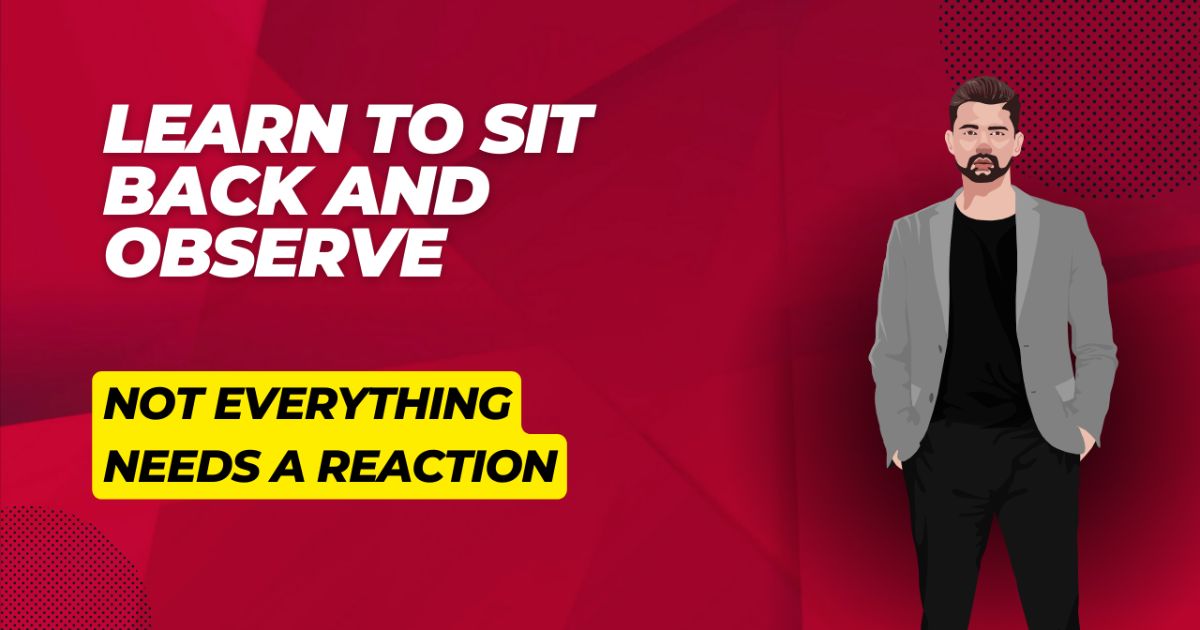In the hustle and bustle of modern life, it’s easy to get caught up in the constant stream of activity and stimuli. However, there’s value in taking a step back and simply observing without reacting. This principle, often encapsulated in the phrase “learn to sit back and observe,” holds relevance in various aspects of life, including health.
Learning to sit back and observe in the context of health entails adopting a mindset of mindfulness and attentiveness to one’s physical and mental well-being. Rather than immediately reacting to every sensation or symptom, it involves taking a moment to assess, understand, and respond thoughtfully.
In today’s fast-paced world, many people are prone to overreacting to minor health issues or stressors, leading to unnecessary anxiety or impulsivity in seeking solutions. By learning to sit back and observe, individuals can develop a more balanced and nuanced approach to their health, allowing for better self-awareness, decision-making, and overall well-being.
Types and Categories
One common type of behavior related to health is reactive behavior, where individuals respond impulsively or emotionally to perceived threats or discomforts. This can manifest as hypochondria, excessive worry about minor symptoms, or overuse of medical resources.
In contrast, mindful observation involves cultivating awareness and non-reactivity towards bodily sensations, emotions, and thoughts. This approach encourages individuals to observe without judgment, allowing for a clearer understanding of their health status and needs.
Read More Blog: Pi123 Essentials: Understanding The Intersection Of Math And Innovation
Symptoms and Signs
Symptoms such as headache, fatigue, or muscle tension are common occurrences in daily life. sit back While they may indicate underlying health issues, they can also be transient and benign.
Psychological signs like anxiety, irritability, or low mood can also impact health and well-being. Learning to observe these signs without immediately reacting can help individuals develop resilience and coping strategies.
Causes and Risk Factors
Biological factors such as genetics, hormonal fluctuations, or pre-existing health conditions can contribute to various health issues. sit back By observing their body’s responses over time, individuals can better understand these factors and manage their health proactively.
Environmental factors like pollution, diet, or lifestyle habits can also affect health outcomes. Through mindful observation, individuals can identify environmental triggers and make informed choices to mitigate their impact.
sit back Diagnosis and Tests

Regular self-monitoring of vital signs, symptoms, and mood fluctuations can provide valuable insights into one’s health status. Simple tools like blood pressure monitors or mood tracking apps can facilitate this process.
In cases where symptoms persist or worsen, seeking medical consultation and diagnostic tests may be necessary. By providing healthcare providers with detailed observations and histories, individuals can facilitate accurate diagnosis and treatment planning.
Treatment Options
Conventional medical treatments such as medication, therapy, or surgery may be recommended for certain health conditions. However, they are most effective when tailored to individual needs based on thorough observation and assessment.
Holistic approaches to health, including nutrition, exercise, stress management, and alternative therapies, can complement conventional treatments. By observing their body’s responses to these interventions, individuals can optimize their health outcomes.
Preventive Measures
Making proactive lifestyle modifications, such as adopting a balanced diet, exercising regularly, getting adequate sleep, and managing stress, can significantly reduce the risk of developing chronic health conditions.
Regular health screenings and check-ups enable early detection of potential health issues, allowing for prompt intervention and better outcomes. Observing changes in one’s body and seeking timely medical advice are essential preventive measures.
Read More Blog: Unlocking the Perfect Laptop Match with the Laptop Finder Quiz
Personal Stories or Case Studies
Sarah’s Journey
Sarah, a 35-year-old professional, used to experience frequent headaches and fatigue due to work-related stress. Instead of immediately resorting to painkillers, she started practicing mindfulness meditation and journaling to observe her stress triggers and responses. Over time, she noticed a significant reduction in her symptoms and improved overall well-being.
Dr. Smith’s Perspective
According to Dr. Smith, a renowned psychiatrist, learning to sit back and observe is crucial for mental health resilience. By cultivating mindfulness and self-awareness, individuals can develop healthier coping mechanisms and reduce the risk of stress-related disorders.
Conclusion
In conclusion, the principle of learning to sit back and observe holds valuable lessons for promoting health and well-being. By adopting a mindful and attentive approach to their physical and mental states, individuals can make informed decisions, cultivate resilience, and lead fulfilling lives.












